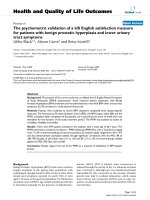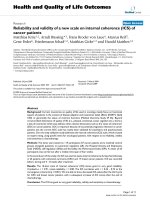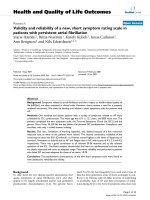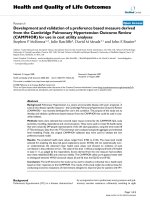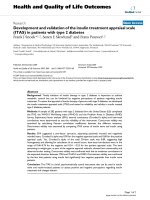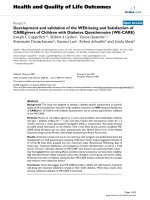báo cáo hóa học: " Construction and validation of a short-form Quality-Of-Life Scale for Chinese Patients with Benign Prostatic Hyperplasia" pptx
Bạn đang xem bản rút gọn của tài liệu. Xem và tải ngay bản đầy đủ của tài liệu tại đây (319.16 KB, 7 trang )
Health and Quality of Life Outcomes
Research
Construction and validation of a short-form Quality-Of-Life Scale
for Chinese Patients with Benign Prostatic Hyperplasia
Yanfang Guo
1,2
, Jingcheng Shi
1
,MingHu
1
and Zhenqiu Sun*
1
Address:
1
Department of Epidemiology and Health Statistics, School of Public Health, Central Sou th University, Changsha, Hunan, PR China
and
2
Huaihua Medical School, Huaihua, Hunan, PR China
E-mail: Yanfang Guo - ; Jingcheng Shi - ; Ming Hu - ;
Zhenqiu Sun* -
*Correspondi ng author
Publishe d: 17 March 20 09 Received: 8 A pril 2008
Health and Quality of Life Outcomes 2009, 7:24 doi: 10.1186/1477-7525-7-24 Accepted: 17 March 2009
This article is available from: />© 2009 Guo et al; licensee BioMed Central Ltd.
This is an Open Access article distributed under the terms of the Creative Commons Attribution License (
/>which per mits unrestricted use, distribution, and reproduction in any medium, provided the original work is properly cited.
Abstract
Background: In 2003, a 74-item quality-of-life (QOL) scale for Chinese benign prostatic
hyperplasia (BPH) patients (BPH-QLS) was developed. Although the scale displayed good reliability
and validity, the time required to complete it may limit its use. The purpose of this study was to
construct and validate a short-form quality-of-life (QOL) scale for Chinese patients with Benign
Prostatic Hyperplasia (BPH).
Methods: According to the previously published 74-item quality of life scale for BPH (BPH-QLS),
we developed a pool of items, then condensed these items and validated the shortened scale, based
on collected data from 163 patients with BPH. We used eight methods to reduce the items.
Results: A 33-item QOL scale for BPH (short-form of BPH-QLS) was constructed. The time take
by the new scale was much shorter than the original one. There was no significant difference
between the 33-item scale and 74-item scale, in terms o f reliability. Moreover, the 33-item BPH-
QLSshowedahighcorrelationwiththe74-item BPH-QLS (r = 0.971 ). Scores generated by the
two scales were not only parallel and coincident but also at the same level.
Conclusion: We concluded that the reliability and validity of the short form of BPH-QLS is close
to those of the 74-item BPH-QLS. It should be a good choice in clinical practice for its greater
compliance and clinical feasibility.
Background
BPH is a common male disorder that, though rarely life-
threatening, greatly affects patients' perceived quality of life
(QOL). QOL is an important component in the evaluation
of BPH treatment strategies. Several BPH-specific QOL
scales have been developed, e.g., the International Prostate
Symptom Score (IPSS), the Danish Prostate Symptom Score
(DAN-PSS-1), the International Continence Society 'male'
questionnaire short-form (ICSmale-SF) and the BPH
Quality of Life Index [1-4]. Although the IPSS and QOL
index are universally used, they can only quantify severity of
lower urinary tract symptoms suggestive of BPH and
evaluate treatment efficacy, and can not fully reflect the
overall quality of life. Moreover, because QOL scale depends
on the culture background, it is necessary to develop a
Chinese version of the scale. In 2003, a 74-item BPH-QLS
with five domains (disease, physical, social, psychological,
satisfaction) was developed for Chinese BPH patients.
Although the scale displayed good reliability and validity
[5,6], the time required to complete it may limit its use.
Demands for efficiency, reduced respondent burden, greater
compliance, and clinical feasibility have led to the
Page 1 of 7
(page number not for citation purposes)
BioMed Central
Open Access
development of shorter questionnaires. The aim of this
study was to construct and validate the short-form of BPH-
QLS and to compare its results with those of the original
instrument.
Patients and methods
This study was conducted in the city or provincial
hospital in Changsha, the capital city of the Chinese
Province of Hunan, from March 2005 to De cember
2005. We stratified the recruitment by patient sources, so
that a balance number of study subjects can be obtained
from inpatient, outpatient, and community based
patient settings. Male patients who came to the
participating hospitals for treatment or physical exam-
ination for lower urinary tract symptoms (LUTS)
suggestive BPH were approached by research assistants
to participate into the study. All the participating
patients were assessed by the rese arc h assistants and
only those patients who were considered competent
were recruited. The research assis tants explained to the
patients of the purpose of the study and signed consents
were obtained from the patients if they agreed to
participate into the study after full explanation. Attentive
digital rectal exam (ADRE) or t ransrectal ultrasound
(TRUS) was used to assess benign prostatic enlargement.
Using t he recommendations of the Fourth International
Consultation on BPH, patients with the following
conditions were excluded: aged < 50 years; with prostate
cancer; prev iously failed invasive treatment for BPH;
possibility of a neurological disease; surgical or wound
history related to the pelvic cavity; history of venereal
disease; taking drugs affecting bladder outlet function; or
unable to adequately express feelings. Self-filled ques-
tionnaires for the full BPH-QLS, SF-36, IPSS were
distributed to the study subjects. In addition, a control
group with no past or current history of BPH randomly
selected among the community care settings m atched by
age and educational level were asked to complete the
questionnaires. This study was approved by the Ethics
Committee of Central South University.
Scale construction
Phase 1
After consulting relevant published QOL s cales for BPH,
such as IPSS, DAN-PSS-1, ICS-BPH, BII, SPI, BPHQOL,
WHOQOL-100, BPH Quality of Life Index, BPH-HRQOL
and BSP-BPH [1-4,7-11], we added 12 new items to the
74-item BPH-QLS according to the consensus reached by
18 relevant experts. An initial draft-item pool (86 items)
was then generated (see addit ional file 1).
Phase 2
Initial expert score was made by a panel consisting of 1 8
member s (specialists in urology, nursing, psychology,
statistics, and public health and BPH patient representa-
tives) according to the importance on a scale of 1–5(1=
least important and 5 = most important). Final score was
determined by 12 of the panel members after further
review and consultation.
Phase 3
Eight (8) statistical methods of analysis were used to
select items in data collected form 163 BPH patients. The
first method was the scoring items by experts. Items
which had total score < 40 (full score was 60 for 12
experts finished the consultation at the end) were
deleted [12]. The second method used coefficient of
variation. Items with a variation coefficient < 25% for
each domain were deleted [12]. The third method used
of discriminatory analysis to retain items which could
distinguish between men with BPH and men without
BPH. The fourth method involved the use of correlation
coefficient to eliminate unimportant items in each
domain [2]. High item-to-item correlation was defined
by a coefficient > 0.8. The fifth method i nvolved the use
of multiple stepwise regression to eliminate non-
significant items in each domain (a
entry
=0.10,a
exit
=
0.15) [9]. The sixth method used Cronbach'a coefficient.
The last 50% of items which induced an increase of
Cronbach'a coefficient in each domain were dele ted
[13]. The seventh method in volved the use of factor
analysis to delete the last 50% of items with low factor
loading [13]. The eighth method involved the use of
cluster analysis to r etain representative items.
Phase 4
Items which selected by at least 6 of the 8 analysis
methods were retained in the scale, while the items
selected by only 5 of the 8 methods were retained only if
recommended by specialist.
Scale scoring
The short form of BPH-QLS with 5 points and of equal
interval (1 low 5 high) was used for the scoring of items,
which included 32 reverse items. Patients were then
asked to select the relevant point on the scale based on
their perception s. Primitive scores were subtracted from
six to get a new score. After the score was renewed, the
higher score indicated the better quality of patient's life.
Scale validation
The major reliability and validity tests were used to
validate the short new QOL instruments [6]. Correlation
coefficients (CCs) were calculated for t he original and
1-week repeat scale and each domain for test-retest
reliability. Internal consistencies for the instrument and
its domains were assessed by Cronbach'a coefficient. The
validityoftheshortformofBPH-QLSwastestedinthree
Health and Quality of Life Outcomes 2009, 7:24 />Page 2 of 7
(page number not for citation purposes)
aspects. For structure validity, we used exploratory factor
analysis and correlation analysis. For criterion validity,
two criteria (SF-36 and IPSS) were used. For discrimina-
tion validity we evaluated whether the scale and domains
could discriminate those with different QOL: men with
and without BPH, patients with BPH of different severity
according to the I PSS (Total score h as a range of 0 to 35:
mild 0–7; moderate 8–19; and severe > 20), and patients
recruited from different settings inpatient, outpatient and
community-based. T-test, correlation coefficient and
profile analysis were then used to compare the short
form of BPH-QLS with the original scale in t erms of
acceptability, reliability, and validity.
Results
Of 163 86-item BPH-QLS questionnaires distributed, 79
(48.5%) were returned from inpatie nts; 45 (27.6%)
from outpatients; and 39 (23.9%) from community-
based patients (see additional file 2). The scale was re-
administered to 40 randomly sampled outpatients one
week after the first distribution. Thirty-one (31) of these
patients returned their c ompleted questionnaires. Of
the 163 patients recruited, 125 completed the SF-36
whilst 153 completed the IPSS and all completed the
new scale.
Additionally, a control group of 34 men with no past or
current history of BPH randomly selected among the
community were matched t o 34 patients (cases) by age
and educational level. The controls were also completed
the questionnaire.
A total of 32 ite ms were selected by using eight methods
together. Among these methods, scoring by experts
selected 36 items, coefficient of variation selected 46
items, discriminatory analysis selected 46 items, multi-
ple regression selected 32 items, Cronbach'a coefficient
selected 59 items, coefficient of correlation selected 53
items, factor analysis selected 54 items, and cluster
analysis selected 46 items (see additional file 3). Finally,
the short form of BPH-QLS consisted of 33 items (32
retained correlation items and 1 global QOL item) (table
1), including four new items: stop and start several times
when you urinate? had a sensation of not emptying
bladder completely after urinating, have to wait for
urination to start and how would you score your quality
of life including five domains (disease, physical, social,
psychological, satisfaction)?
Reliability
The test-retest CC was 0.858 for outpatients (not
surgical), Cronbach'a coefficient was 0.952, providing
evidence that the short form of BPH-QLS was stable and
reliable in the light of generally recognized criteria and if
good reliability is deemed as a test-retest CC of > 0.7 and
a > 0.8 [6].
Validity
The content validity of the 33-item scale was validated
with BPH-QLS, moreover, 18 relevant experts approved
the final item pool.
Table 1: Short-form of BPH-QLS (33-item scale)
new scale Items
1 Had to urinate again less than 2 hours after you finished
urinating
2 Strong urge to urinate
*3 Stop and start several times when you urinate?
4 Smaller or weaker force of your urinary stream
*5 Had a sensation of not emptying bl adder completely after
urinating
*6 Have to wait for urination to start
7 Dribbling and wetting pants a few minutes after finishing
urinating
8 Getting up t o urinate during the night
9 Have the symptoms of BPH brought trouble to your life?
10 Haveyoubeenworriedthatyouwouldblockupandnot
able to urinate?
11 How often have you worried about the urinary condition
during the past 2 weeks?
12 Has the nocturia interfered with your sleep?
13 Has your sexual l ife been affected by the disease?
14 Do you feel uncomfortable when you going out or
traveling, because of BPH?
15 If you have to spend the rest of your li fe w ith prostat e
symptoms just as they are now how would you feel about
that?
16 Moving things heavier than 10 kg
17 Daily activities outside (e.g. shadowboxing)
18 To what extent can you take care of yourself
19 How about your sleep?
20 Have you given up some hobbies because of the illness?
21 Has your family life been interfered with by the ill ness?
22 Has your family responsibility been lost because of the
illness?
23 Has the expectation f rom ot hers fallen because of your
illness?
24 Has your contact with frie nds reduced since your illness?
25 Have you been worried that therapy will cost so much
money that you can't afford it?
26 Have you felt uneasy about your health?
27 Have you been worried about the outcome of the
disease?
28 To what extent have you felt downhearted and
depressed?
29 Do you look on yourself as a burden to the family and
society?
30 Have you become more irritable than before?
31 Are you satisfied with your income?
32 Generally, are you satisfied with your health status?
*33 How would you score your quality of life including five
domains(disease, physical, social, psychological,
satisfaction)? (full mark is 100)__________
*Newitem
Health and Quality of Life Outcomes 2009, 7:24 />Page 3 of 7
(page number not for citation purposes)
Structure vali dity of the short -form of BPH-QLS gave a
Kaiser-Meyer-Olkin test value of 0.858 and a significant
Bartlette's test of sphericity (p < 0.001). A total of 12
common factors with the best interpretation were
extracted after varimax rotation, and had a cumulative
variance of 83.078% (see additional file 4). The 12
common factors were stratified into five domains, based
on the conceptual model (Table 2).
The structure validity was further assessed using correla-
tion analysis of scores between domains, domains and
the scal e. The CCs for disease, physical, social, psycho-
logical and satisfaction with the scale were 0.828, 0.723,
0.830, 0 .877, and 0.786, respectively. The CCs between
domains were 0.424 for disease and physical; 0.515 for
physical and social; 0.777 for socia l and psychological;
and 0.612 for psychological and satisfaction.
Criterion validity of the short-form of BPH-QLS is
summarized in table 3. The domains of th e short-form
of BPH-QLS and SF-36 were significantly correlated
(p < 0.01) with CCs of 0.267~0 .773, most of which
were > 0.300. The disease domain of the new scale and
that of the IPSS were also significantly correlated
(p < 0.01; CC = 0.901).
For discriminatory validity of the new scale, paired t-tests
showed that scores for patients without BPH were
significantly higher than men with BPH for all domains
(Figur e. 1) . In terms of severity categorized by the IPSS
(mild, moderate, and severe), ANOVA tests showed that
patients wit h mild BPH had the highest score within the
disease domain (p < 0.05). For the physical domain,
mild and moderate groups showed higher scores than
the severe group. However, in the social, psychological,
satisfaction domain scores and the total score, the
moderate group was not significant difference compared
to the mild, and these two groups all exhibited higher
score than that in the severe group (Figure. 2). We also
compared the scores among community-based patients,
outpatients and inpatients, and ANOVA showed a
significant difference across the domains and scale scores
of the three groups (p < 0.01). Compared between each,
community-based patients had the highest scores in the
disease, physical domains and the scale, while inpatients
had the lowest. Outpatients and community-based
patients had no significant difference in score for the
physical and social domain, while inpatients had a lower
score. For the satisfaction domain, outpatients and
Table 2: Construction of the short-form BPH-QLS
Domain (variance, %) Common factor Related Items N items
Disease (47.501%) 1-symptoms of incont inence and effects of LUTS on daily life 1,2,4,5,8–15 15
6-urine stoppage 3, 6 2
8-dribbling after voiding 7 1
Physical (8.316%) 5-body activity 17,18 2
10-sleep 19 1
11-physical activity 16 1
Social (9.363%) 3-social function 22,23,24 3
4-social activity 20,21 2
Psychological (14.899%) 2-emotional effects of disease 26–29 4
9-worry about the disease 25 1
12-temper 30 1
Satisfaction (3.001%) 7-life satisfaction 31,32 2
Tab le 3: The CCs of the short-form BPH-QLS with other
instruments
Short-form BPHQLS SF-36 IPSS IPSSQOL 74-item BPHQLS
Disease domain 0.595** 0.901** 0.755** 0.980**
Physical domain 0.663** 0.287** 0.262** 0.905**
Social domain 0.769** 0.400** 0.381** 0.938**
Psychological 0.742** 0.510** 0.506** 0.956**
Satisfaction 0.610** 0.411** 0.475** 0.864**
Total 0.822** 0.694** 0.609** 0.971**
**P <0.01
Figure 1
The quality-of-life scores for patients with BPH or
not.
Health and Quality of Life Outcomes 2009, 7:24 />Page 4 of 7
(page number not for citation purposes)
inpatients had similar scores but lower than community-
based patients (Figure. 3).
Comparison between the short scale and the full scale
The 74-item scale takes approximately 12–22 min to
complete, while the short scale only 6–9 min. Out of 50
randomly recruited patients 49 (98%) considered the
33-item scale to be more acceptable than the 74-item scale.
Pearson's correlation analysis showed that there were
significant correlations in each domain between short-
form of BPH-QLS and BPH-QLS with CCs of 0.864–
0.980 (table 3), and correlation of the total score
between the two scales r
2
= 0.947. The short-form scale
accounted for 94.7% of the explained variance of the
74-item one (table 4).
Profile analysis indicated that the two scales were not
only parallel (F = 0.98, p = 0.419) and coincidence (F =
1.05, p = 0.307) but also of the s ame leve l (F = 2.00, p =
0.097) (Figure 4).
Discussion
Quality of life measures have gained i ncreasing attention
as clinically relevant patient-center ed endpoints in
clinical trials. However, in a clinical setting, a lengthy
quality of life scale is problematic for both the patient
and the urologist. Short scale minimize a patient's time
and effort, and thus increase a patient's willingness to
complete the scale. The short-form BPH-QLS developed
in our study was constructed based on WH O's definition
of quality of life and a previously developed 74-item
scale. In this study, we added some new items which
were considered important by urologists and patients,
while ignored in the 74-item scale, after consulting
relevant published papers, experienced urologists and
some patients. Taking t he patient's educational level into
account, some ite ms were expressed in spoken language.
For example, 'no emptyi ng sensation after urination'
change to 'had a sensation of not emptying bladder
completely after urinating'.
Item reduction is a key technique in constructing the
short scale. For different reduction methods get different
results, item reduction was carried out from different
angles as much as possible. The easier practice is to use
Figure 2
The quality-of-life scores for different severity
groups.
Figure 3
The quality-of-life score for different sources.
Table 4: The correlation between the 33-item and 74-item
questionnaires
Total original
score (
X
± S)
rR
2
P-value
74-item BPH-QLS 288.82 ± 45.66 0.971 0.947 0.000
33-item BPH-QLS 119.32 ± 22.61
Figure 4
Profiles of domains between t he two scales.
dise-disease domain; physic-physical dimain; soci-social
domain; psyc-psychological domain; sati-satisfaction domain
Health and Quality of Life Outcomes 2009, 7:24 />Page 5 of 7
(page number not for citation purposes)
systematic analysis and clinical experience to select
items. This approach, is o ften influenced by the
valuator's understanding of quality of life. Since there
was the need to use objective methods to get more
credible results [13], we used scoring by experts,
coefficient of variation, discriminatory analysis, multiple
regression, Cronbach'a coefficient, coefficient of correla-
tion, factor analysis, an d cluster analysis to objectively
select items that were representative enough to assess the
quality of life of BPH patients [2,9,12,13]. Coefficient of
correlation, factor analysis and cluster analysis methods
were used based on the relevant of the data str ucture
from independence and representative aspect. According
to the variation of the data structure, w e used coefficient
of variation, discriminate analysis, and stepwise regres-
sion analysis to select items from sensitivity and the
importance aspect [12]. Cronbach'a coefficient was used
to item reduction on the basis of the item internal
consistency [13]. The previous study of BPHQLS did not
use scoring by experts and Cronbach'a coefficient to
select items. The use of experts is considered an
important method for the reduction of items. In our
study, we used 12 experts with over 10 years of
experience. This was consistent with suggestions by Sun
et al [14]. Furthermore, the use of Cronbach'a coefficient
was important in the selection of items with higher
internal consistency and stability, thereby resulting in
the selection of items that enhanced the assessment
quality of life.
The clinical experience was used to identify the items
that did not meet the statistic criteria but considered
important from a clinical perspective [2]. For example,
question "has your sexual life been affected by the
disease?" which was selected by only 5 of the 8 methods
was considered to retain since all the foreign BPH-QOL
scales included sexual life items and some even
contained more than o ne third, while response rate of
this item was very low because of the Chinese tradition
to assign much importance on the family. Then, all the
items were sensitive, independent and representative,
according to the construction st rategy and item selec tion
methods.
The compliance of subjects is a very important indicator
of the effectiveness of a scale, and this is often influenced
bythelengthofthescale(theshorterthescaletheeasierit
is to administer). Current ly, IPSS, BII and BPH-H RQOL9
are widely used in clinical setting becaus e they are short,
and are reported to have completion rates of o ver 85%
[15,16]. In our study, the acceptance rate for the new short
scale was 98%, and the time which the short scale takes
was much less than the original long scale. Expressing
some of the items in a spoken language format also
enhanced acceptability and a higher rate of completion.
In our study, not only were the reliability and validity of
thescaletested,thecomparisonwasalsousedtoassess
the differences between the short-form of BPH-QLS and
the original long scale. The results indicated that the new
scale w ere as good as the original scale. Although there
were fewer items in the new scale, the content validity
seemed better than the original one by the experts'
subjective evaluation and the additional self-assessment
globe QOL item. The new short scale accounted for
94.7% of the explained variance of the 74-item scale
after half of the items were reduced. The CCs of the
short-form of BPH-QLS with SF-36, IPSS, IPSSQOL score
and 74-item BPH-QLS were all high (0.822, 0.901,
0.775, and 0.971, respectively), showing good criterion
validity. Similar to the 74-item BPH-QLS, the 33-item
scale could also discriminate the following kinds of
persons: patients with BPH and those without BPH;
patients wit h different degree of symptoms; in-patients,
out-patients, and community patients [17].
Conclusion
This study used scienti ficallysoundingstrategyto
construct a short-form of BPH-QLS for Chinese men.
The new scale reliable and valid with improved
acceptance. Hence, we concluded t hat the reliability
and validity of the short form of BPH-QLS is close to
those of t he 74-item BPH-QLS. It should be a good
choice in clinical practice for its greater compliance and
clinical feasi bil it y.
Abbreviations
BPH-QLS: A Quality of Life Scale for patients with BPH
Prior Test Version; QOL: quality of life; DAN-PSS-1:
Danish Prostate Symptom Score; ICSmaleSF: Interna-
tional Continence Society male questionnaire short-
form; SF-36: The Medical Outcomes Study 36-Item
Short-Form Healt h Survey; BPH-QoL: A Quality of Life
Scale for patients with BPH; WHOQoL-100: the WHO
Quality of Life.
Competing interests
The authors declare that they have no competing
interests.
Authors' contributions
YG collected data and drafted the whole manuscript. JS
was involved in conception and designed the study. MH
contributed in interpretation of data and in selection of
patients, ZS design the study and he was the soul of this
article. All authors read and approved the final manu-
script.
Health and Quality of Life Outcomes 2009, 7:24 />Page 6 of 7
(page number not for citation purposes)
Additional material
Additional file 1
86-item scale (74-item BPH-QLS +12 new items). The file pr ovide d
represen t the initial draft-item pool (86 items) which included 12 new
items and 74 items of BPH-QLS.
Clic k here for file
[ ontent/supplementary/1477-
7525-7-24-S1.doc]
Additional file 2
The demographic structures of the sample. The table provided
represen ts the baseline characteristics for patients who were in the three
different so urces.
Clic k here for file
[ ontent/supplementary/1477-
7525-7-24-S2.doc]
Additional file 3
The process of the item selection. The table showed the results in
sele cting items by eight statistica l methods of analysis.
Clic k here for file
[ ontent/supplementary/1477-
7525-7-24-S3.doc]
Additional file 4
Factor loadings of the short form of BPH-QLS. The table showed the
factor analysis of the short fo rm of BPH-QLS.
Clic k here for file
[ ontent/supplementary/1477-
7525-7-24-S4.doc]
Acknowledgements
The research was funded by the National Key Technologies R&D
Programs in the 10
th
five-year plan in China.
References
1. Barry MJ: Evaluation of symptoms and quality-of-life in
men with benign prostatic hyperplasia. Urology 2001, 58
(suppl):25–32.
2. Hansen BJ, Flyger H and Brasso K, et al: Validation of prostatic
hyperplasia. Br J Urol 1995, 76:451–458.
3. Donovan JL, Abrams P and Peters TJ, et al: The ICS – 'BPH' study:
the validit y and reliability of the ICSmale questionnaire. Br J
Urol 1996, 77(4):554–562.
4. Barry MJ: Measuring disease-specific health status in men
with benign prostatic hyperplasia. Med C are 1995, 33:
As145–As155.
5. Jingzeng Shi, Zhenqiu Sun and Taisheng Cai, et al: Development
and validation of a quality of life scale for Chinese patients
with benign prostatic hyperplas ia – the development and
the item screening. Chinese Journal of Health Statistics 2003, 20
(3):158–161.
6. Jingzeng Shi, Zhenqiu Sun and Taisheng Cai, et al: Development
and validation of a quality of life scale for Chinese patients
with benign prostatic hyperplasia. BJU Int 2004, 94:837–844.
7. Eri LM: Measuring the quality of life of patients with benign
prostatic hyperplasia. Eur Urol 1992, 21:257–262.
8. Fowler FJ and Wennberg JE, et al: Symptom status and quality of
life following prostatect omy. AMA 1988, 259:3018–3022.
9. Lukacs B, Comet D and Grange C, et al: Construction and
validation of a short-form benign prosta tic hypertrophy heal
th-related quality-of-life questionnaire. Br J Urol 199 7,
80:722
–730.
10. Epstein RS, Deverka PA and Chute CG, et al: Validation of a new
quality of life questionnaire for benign prostatic hyperplasia.
JClinEpidemiol1992, 45:1431–1445.
11. Bertacc ini A, Martinelli A and Ceccarelli R, et al: Development and
validation of the BSP-BPH (Bononian Satisfaction Profile –
Ben ign Prostatic Hyperplasia) a "disease-specific" question-
naire for the evaluation of health related quality of life in
patients with benign prostatic hyperplasia. Arch Ital Urol Androl
2004, 76(3):103–9.
12. Fang Jiqian: The methods and appli cation of quality of life
measurement. Beijing: Beijing Medical University Press; 2000,
263–266.
13. Donovan TJ, Peters J and Abr ams P, et al: Scoring the short
form ICSmale-SF questionnaire. Journal of Urology 2000,
164:1948–1955.
14. Sun Zhenqiu: Medical Statistics (second edition). Beijing:
People's Medical Publishing House; 2005, 531– 541.
15. Stoevelaar HJ, Beek CV and Nijs HGT, et al: The symptom
questionnaire for benign prostatic hyperplasia: an ambig-
uous indicator f or an ambiguous dis ease. Br J Urol 1996,
77:181–185.
16. Cam K, Senel F and Akman Y, et al: The efficacy of an
abbreviated model of the international prostate symptom
score in evaluating benign prostatic hyperplasia. BJU Interna-
tional 2003, 91:186–189.
17. Shi Jingzheng: Development of a quality of life scale for
Chinese patients with benign p rostatic hyperplasia. Master
thesis Central South University, Public Healt h School, Epidemiology
and Health Statistics; 2003, 6.
Publish with Bio Med Central and every
scientist can read your work free of charge
"BioMed Central will be the most significant development for
disseminating the results of biomedical research in our lifetime."
Sir Paul Nurse, Cancer Research UK
Your research papers will be:
available free of charge to the entire biomedical community
peer reviewed and published immediately upon acceptance
cited in PubMed and archived on PubMed Central
yours — you keep the copyright
Submit your manuscript here:
/>BioMedcentral
Health and Quality of Life Outcomes 2009, 7:24 />Page 7 of 7
(page number not for citation purposes)

